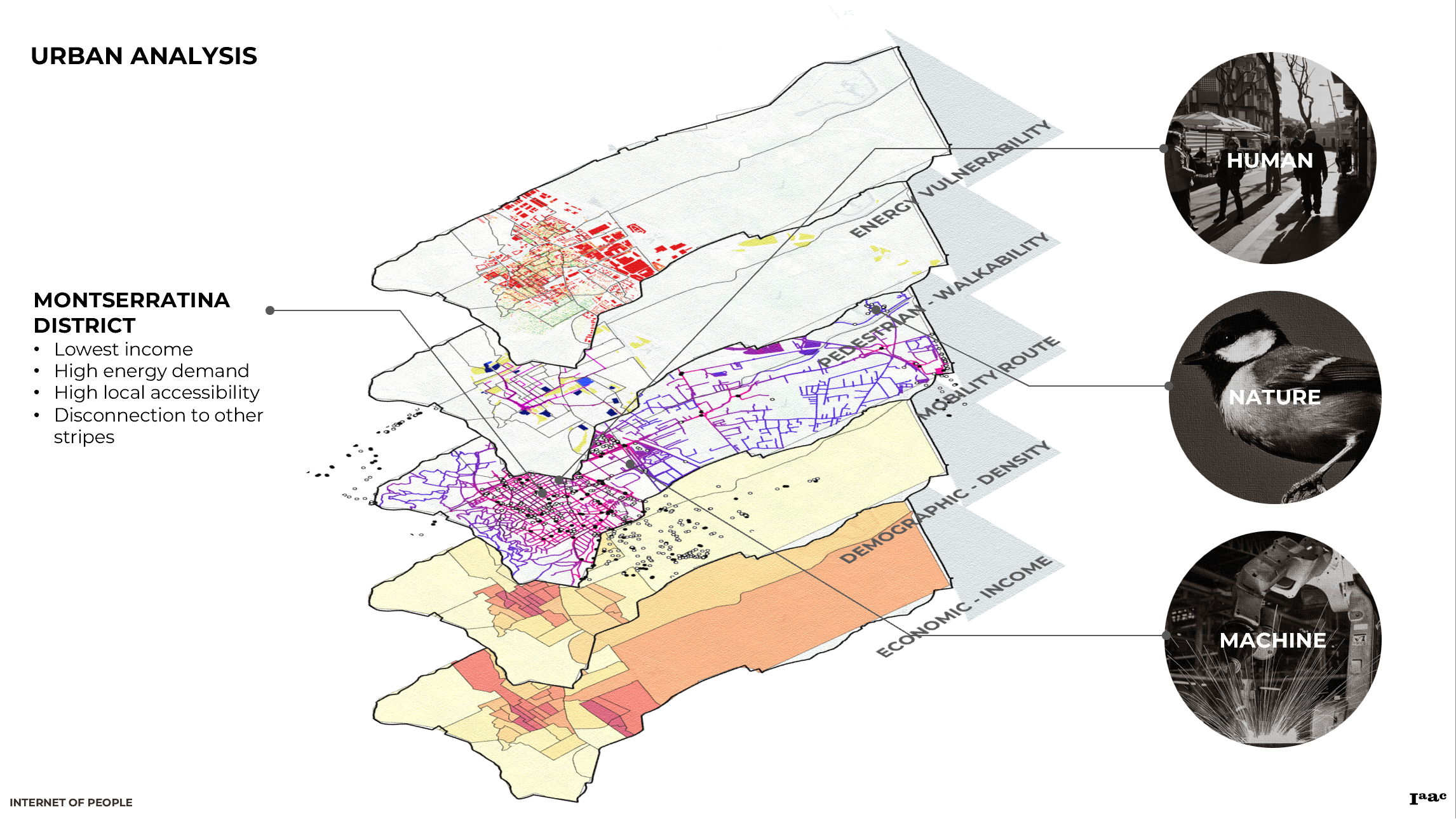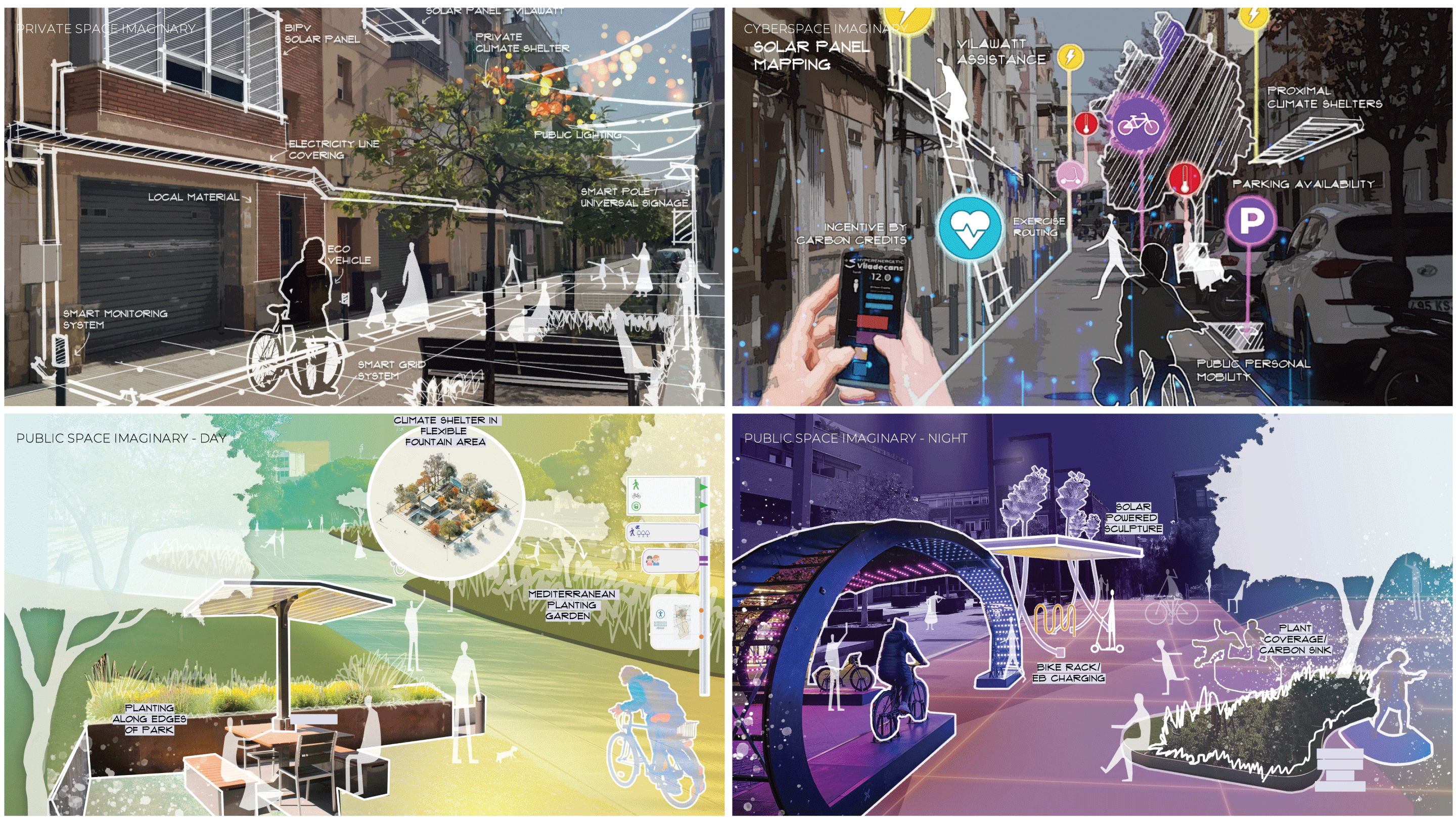By 2100, the global temperature is forecasted to increase from 2 to 4 degrees Celsius due the effects of Greenhouse Gases Emissions and Human Activities. The City of Viladecans has developed a Vision by 2030 which expects the city to become EMISSIONS NEUTRAL, and EMISSIONS NEGATIVE by 2050. For approaching this goal, HYPENERGETIC VILADECANS establishes a multidimensional understanding of energy:
- THERMAL ENERGY, as the energy the body needs and uses to regulate its temperature in relationship with its surroundings
- KINETIC ENERGY, as the energy used to mobilize through time and space
- ELECTRIC ENERGY, as the energy that lights up households and daily lives
- BIOCHEMICAL ENERGY, as the energy involved in the internal cycles of the body that lead to well-being, health, nutrients and energetic intake

HYPERENERGETIC LOW CARBON MONTSERRATINA
Through an understanding of different spatial layers, including ENERGY VULNERABILITY, PEDESTRIAN WALKABALITY, MOBILITY ROUTE, POPULATION DENSITY and ECONOMIC VULNERABILITY, a hot-spot of vulnerability and potential in the core of the urban zone in the neighborhood of LA MONTSERRATINA.

LA MONTSERRATINA is a neighborhood characterized by having the lowest income and highest energy demand in the city, being mostly designated for residential usage and few open space. Nevertheless, it is located within a 15-minute-walking radius polygon of high accesibility to parks and amenities. This, accompanied by the way the digital realm is starting to be a useful tool for connecting people to their environment, lead to identify three typologies of implementation to design a HYPERENERGETIC MONTSERRATINA: the Private Space, the Public Space and the Cyber Space.

After developing a participatory diagnosis, some insights were gathered from perceptions and opinions of the inhabitants of the neighborhood about their relationship with their surroundings. Among these, the main highlights include that they acknowledge having conventional-sourced energy consumption, are comfortable with having open space at a walking distance of less than 15 minutes, regardless of not having it inside of Montserratina and mostly mobilize by walking. These insights provide tools for converting needs into possible programs for each typology.

QUICK WIN STRATEGIES: CARBON NEGATIVE ZONE
The project’s strategies begin by focusing on four key narratives: Thermal, Kinetic, Biochemical, and Electricity. We gather data and insights from the people of Viladecans to understand their lifestyles and aspirations for city improvement, particularly in the realm of energy. From these insights, we connect each energy source to a range of programs, including active mobility, carbon credits, climate shelters, green pedestrian initiatives, local materials usage, smart grid systems, solar photovoltaics, smart poles, universal design, and Vilawatt. These implementation programs span across all types of spaces, including private properties owned by citizens, public spaces managed by the government, and cyberspace facilitated by the Hyperenergetic platform.

PRIVATE SPACE DESIGN GUIDELINE
For private space design, our guidelines focus on easily implementable programs where citizens by themselves and can also receive government support. This includes installing solar panels and utilizing local materials for construction, along with implementing a smart grid system to facilitate energy trading and increase efficiency. To address urban heat and reduce AC usage, private climate shelters using large trees can be integrated into residential areas, while streets are redesigned to accommodate zero-carbon mobility options. By encouraging these initiatives, we empower citizens to contribute to sustainability while enhancing the livability of private spaces.

PUBLIC SPACE DESIGN GUIDELINE
The public space design guidelines focus on easily accessible interventions, where citizens can engage and activate space with energy efficiency. The existing plazas neighbouring La Monserratina will be improved by familiarising community members with inclusive, comfortable civic spaces. By providing open space alternatives for thermal comfort such as climate shelters/increased tree canopies, increased kinetic movement with recreational furniture, EV charging stations for low carbon mobility, and promoting active pedestrians with universal wayfinding, increased efficiency will reduce the friction from healthy living. Due to more dynamic features of plazas, biochemical comfort will provide citizens with carbon friendly places to stay and play. Connections to hiking routes in the mountain will be encouraged via signage and walkability will be upgraded with solar powered night lighting as well as parking locators embedded in the Hyperenergetic Viladecans application. We seek to engage citizens within their communities to foster sustainable practices of wellness in the public realm, increasing green infrastructure and the energy efficiency of public spaces.

CYBER SPACE DESIGN GUIDELINE
To integrate and connect people to the physical interventions in the private and public space, an interactive platform is provided for inhabitants to register their sustainable activities, including time spent in a climate shelter instead of using the A/C, making a trip in active non-motorized modes instead of the private vehicle, generating energy from solar panels rather than from consuming it from the conventional grid, or exercising in the open space, among others.
These activites translate into CARBON CREDITS that users can exchange for obtaining services within the same circular economy of sustainable activities, for example, renovating subscriptions to solar panels, getting public transport discounts, renting public bikes, etc. Each transaction raises awareness to users by making tangible how each minute spent in these activities translate into kWh saved, money saved and tons of CO2 avoided, as well as setting the rate of completion for each inhabitant to achieve carbon neutrality. Additionally, the tool provides a mapping service for identifying the location of each activity in space.
Each of the interventions mentioned above translate into imaginaries of how space can be utilized in innovative ways that also represent a more efficient and sustainable use of energetic resources.

STAKEHOLDERS AND FEASIBILITY MODEL
We’ve been developing a project structure and financial model aimed at ensuring long-term sustainability. Our approach begins by empowering citizens to participate and collaborate, driving the project from the grassroots level. Viladecans government serves as the central coordinating body for this endeavour.
- Initially, citizens register their activities on a platform. These activities can range from installing photovoltaic systems to using public transportation, spending time in public spaces, or reducing air conditioning usage.
- Next, a smart monitoring system and platform calculate citizen participation data. Through this process, tech companies and the private sector can contribute by exchanging data and providing funding support for the project.
- Subsequently, carbon credits generated are stored in a central market. Private sectors or industrial estates can then purchase carbon credits from the community, with the funds returning to the community. This creates a cycle where benefits return to the community, allowing people to exchange credits for low carbon emission activities, services, and products.
- Furthermore, citizens can subscribe to services such as PV installation or receive discounts on public facilities and transportation. Shop owners and commercial sectors can also participate by offering eco-friendly products and services.
In conclusion, this cyclical process, with the government as the central coordinator, aims to transition Viladecans into a low carbon emission city by 2030, ensuring long-term sustainable management.

CONCLUSION
The Hyperenergetic City initiative aims to provide alternative scenarios to transition the city towards low carbon emissions by 2030 and eventual carbon neutrality. This transformation is driven by implementing programs across various energy narratives: Thermal, Kinetic, Biochemical, and Electrical. Beginning with La Monsterratina as a flagship model due to its vulnerability, the project seeks to attract more participants and scale up to Viladecans city. Integration across private, public, and cyberspaces is facilitated through smart monitoring and grid systems. The government leads with policies and programs, fostering bottom-up change where citizens support one another in adopting sustainable behaviours.
“To become a Hyperenergetic City, to become a Low carbon community Viladecans.”


